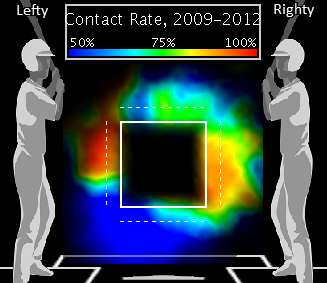The Emergence of Edwin Jackson (Finally)
 Sam Waters |
Sam Waters |  Tuesday, May 22, 2012 at 5:30PM
Tuesday, May 22, 2012 at 5:30PM
Edwin Jackson has had what some might call an up-and-down career to this point. At times tantalizing, at times infuriating, the right-hander has pitched for six different teams over the last five years, with an ERA bouncing back and forth between the mid-fours and mid-threes. A look at his skill independent ERA (SIERA) though, indicates that he pitched at about replacement level from 2007 to 2008, before going on to perform at about league average from 2009 to 2011. This brings us to 2012. Today, Edwin Jackson is no longer a kid filled with the luster of youthful potential- he is 28 years old- but he seems to finally be rising to those lofty expectations that fans probably gave up on a couple of years ago. Jackson is posting the best strikeout and walk rates of his career, and with a 3.13 SIERA, looks to be emerging as one of the better arms in the National League.
So what is Jackson doing differently? Well, his fastball velocity is a little lower than normal, his pitch selection is not radically different, and he’s hitting the strike zone at the same rate as in years past, so we can rule out these factors as explanations for his improved performance. The major difference this year that jumps out from Jackson’s profile is a marked rise in swinging strike rate. After hovering around 10% over the last three years, Jackson shot up this season to an elite 13.1%, second among all qualifying starters. The ability to induce more swing-and-misses explains Jackson’s uptick in performance, but this is not the end of our investigation. The more important issue is how Jackson is suddenly getting all of these swinging strikes.
Batters are swinging at the same rate of Jackson’s pitches both inside and outside the zone and making contact at the same rate on pitches inside the zone as they always have. The difference this year is their ability to make contact outside of the zone. After allowing contact rates around 60% outside of the zone since 2009, Jackson is surrendering contact only 43.3% of the time on would-be balls.
|
Season |
Team |
Swing% Outside Zone |
Swing% Inside Zone |
Contact% Outside Zone |
Contact% Inside Zone |
%Pitches Inside Zone |
Swinging Strike % |
|
2009 |
Tigers |
27.2% |
71.0% |
57.9% |
88.0% |
48.1% |
9.8% |
|
2010 |
2 Teams |
29.5% |
68.2% |
55.9% |
87.7% |
46.6% |
10.4% |
|
2011 |
2 Teams |
30.5% |
68.4% |
64.3% |
88.3% |
46.5% |
9.2% |
|
2012 |
Nats |
31.6% |
69.3% |
43.3% |
88.1% |
46.2% |
13.1% |
A big reason for this fall in contact rate is Jackson’s improvement in locating the ball outside of the zone. He has done a much better job this year of keeping the ball down and away than he did earlier in his career:
|
Pitches Outside of Strike Zone |
||||
|
Time Period |
Up% |
Down% |
In% |
Away% |
|
2012 |
22.6% |
60.8% |
28.8% |
58.9% |
|
2009-2011 |
31.8% |
53.0% |
32.7% |
50.6% |
When Jackson does keep the ball down, hitters have a much harder time making contact. (This is not unique to Jackson- on average, all pitchers do a better job avoiding contact on balls below the zone than balls above the zone.) The graphic below shows the stark contrast in contact rates for Jackson below the zone and above or on the sides of the zone.

Hitters have always had trouble with getting bat to ball on Jackson on pitches low and away. Now that Jackson is hitting those spots more often, he is allowing less contact overall. Not only are hitters missing more often, but when they do make contact it is much weaker. On pitches outside the strike zone that are put into play, Jackson is getting more ground balls and allowing almost no line drives.
|
Pitches Outside of Strike Zone |
|||
|
Time Period |
Groundball% |
Fly Ball% |
Line Drive% |
|
2012 |
75.0% |
20.8% |
4.2% |
|
2009-2011 |
59.7% |
23.4% |
16.8% |
This new batted-ball profile might help to explain why Jackson has a .245 batting average on balls in play (BABIP) after posting a higher than average BABIP throughout the early portion of his career. Jackson’s drawing of weaker contact outside the zone indicates that what some would call a “lucky” BABIP is not completely a result of random variation or external factors, but is at least partly a result of weaker contact stemming from better location.
If Jackson starts missing high again all of these improvements could go out the window. But if he continues to keep the ball down he should be able to sustain a high swinging strike rate and continue inducing weaker contact. The baseball world has seen many flashes of Edwin Jackson's ace potential. This time he could be here to stay.
